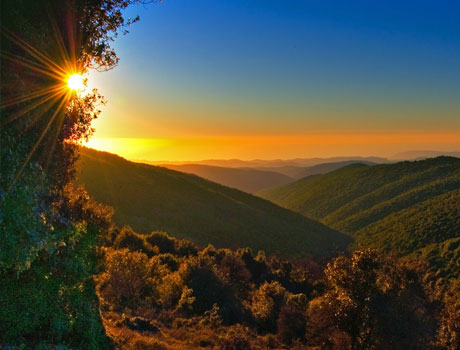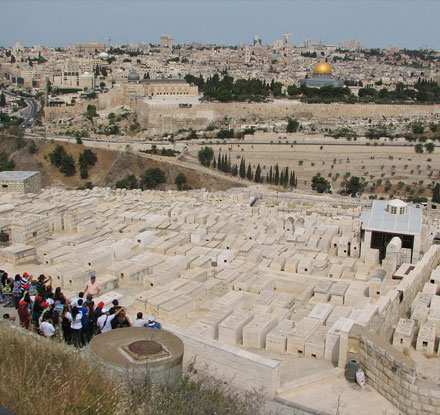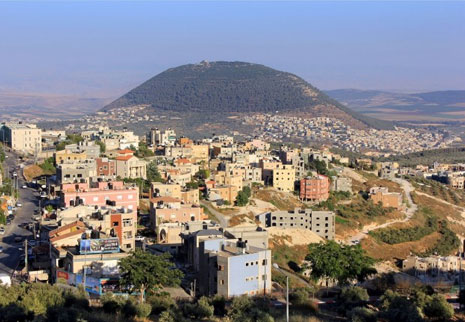Israel
Country statistics

Land area: 7,849 sq miles (20,329 sq km)
Total area: 8,019 sq miles (20,770 sq km)
Population (2012 est.): 7,590,758 (growth rate: 1.541%); birth rate: 18.97/1000; infant mortality rate: 4.07/1000; life expectancy: 81.07; density per sq km: 319
Capital City: Jerusalem
Monetary unit: Shekel
Languages: Hebrew (official), Arabic, English
Ethnicity/race: Jewish 76.4% (of which Israel-born 67.1%, Europe/America-born 22.6%, Africa-born 5.9%, Asia-born 4.2%), non-Jewish 23.6% (mostly Arab) (2004)
Religions: Jewish 75.6%, Muslim 16.9%, Christian 2%, Druze 1.7%, other 3.8% (2008)
Country introduction

Israel is located in South-west Asia, at the eastern end of the Mediterranean Sea. It is bordered by Egypt on the west, Syria and Jordan on the east, and Lebanon on the north.
Israel is divided into three main regions lengthwise: the coastal plain, the mountain region, and the Jordan Valley Rift.
The country's coastal plain spans the western strip, stretching from Rosh Ha-Nikra in the north to the Sinai Peninsula in the south. The plain is 4 to 7 km (2 to 4 miles) wide in the north, expanding as it moves southward to about 50 km (31 miles). The soil in the coastal plain is fertile; there are several water sources, and the region includes the country's major transportation arteries. The coastal plain is densely populated with most of Israel's major cities, including Tel Aviv and Haifa. The plain is divided from north to south into the Galilee Plain, the Acre Plain, the Carmel Plain, the Sharon Plain, the Mediterranean Coastal Plain, and the Southern Coastal Plain. East of the coastal plain are the lowlands, moderate hills that create a transitional region between the coast and the mountains.
The mountainous region of Israel stretches from Lebanon in the north to Eilat Bay in the south, between the coastal plain and the Jordan Valley Rift. Its highest peaks are the Galilee's Mount Meron at 1,208 m (3,963 ft) above sea level, Samaria's Mount Ba'al Hatsor at 1,016 m (3,333 ft) and the Negev's Mount Ramon at 1,037 m (3,402 ft) above sea level. Most of the less densely populated mountainous region is stone or rocky ground. The climate in the northern mountainous regions is Mediterranean and rainy, while the southern sections are a desert. The key stretches of the mountainous region are the Galilee in the north, the Carmel, the hills of Samaria, the Judean hills, and the Negev highlands. The contiguity of the mountainous region is interrupted at two points by major valleys - the Yizre'el (Jezre'el) Valley separating the Galilee mountains from the hills of Samaria, and the Be'er Sheva-Arad Rift separating the Judean hills from the Negev highlands. The eastern slopes of the Samarian hills and Judean hills are the Samarian and Judean deserts.
The rift extends the entire length of Israel from the northern town of Metula to the Red Sea in the south. The rift was caused by seismic activity, and is part of the Afro-Syrian rift which extends from the Syrian-Turkish border to the Zambezi River in Africa. Israel's largest river, the Jordan, flows through the Jordan Valley and includes Israel's two lakes: the Kinneret (Sea of Galilee), the largest body of fresh water in Israel, and the salt water Dead Sea, the lowest point on earth. The Jordan Valley is divided from north to south into the Hula Valley, the Kinneret Valley, the Jordan Valley, the Dead Sea Valley and the Arava.
The hilly Golan region is east of the Jordan River. The Israeli Golan Heights are the end of a large basalt plain, mostly located in Syria. North of the Golan Heights is Mt. Hermon, Israel's highest peak at 2,224 meters above sea level.
The culture

Israel is a Jewish state, with a significant Arab Christian and Muslim population, as well as Druze and Baha'i minorities (both located in the north of the country) and Bedouin (in the Negev desert, in the south). The cultural aspects of the country are generally found in the smaller towns and villages, or in the kibbutzim.
Israel is the only country in the world where life revolves around the Hebrew calendar. Work and school holidays are determined by the Jewish holidays, and the official day of rest is Saturday, the Jewish Sabbath. Israel's three most significant biblical festivals are Rosh Hashanah, Yom Kippur and Sukkot. Israel's substantial Arab minority has also left its imprint on Israeli culture in such spheres as architecture, music, and cuisine.
Israeli literature is primarily poetry and prose written in Hebrew, as part of the renaissance of Hebrew as a spoken language since the mid-19th century, although a small body of literature is published in other languages, such as English. By law, two copies of all printed matter published in Israel must be deposited in the Jewish National and University Library at the Hebrew University of Jerusalem. The Hebrew Book Week is held each June and features book fairs, public readings, and appearances by Israeli authors around the country. During the week, Israel's top literary award, the Sapir Prize, is presented. In 1966, Shmuel Yosef Agnon shared the Nobel Prize in Literature with German Jewish author Nelly Sachs.
Israeli music contains musical influences from all over the world; Sephardic music, Hasidic melodies, Belly dancing music, Greek music, jazz, and pop rock are all part of the music scene. The nation's canonical folk songs, known as "Songs of the Land of Israel", deal with the experiences of the pioneers in building the Jewish homeland. Among Israel's world-renowned orchestras is the Israel Philharmonic Orchestra, which has been in operation for over 70 years and today performs more than two hundred concerts each year. Israel has also produced many musicians of note, some achieving international stardom. Itzhak Perlman, Pinchas Zukerman and Ofra Haza are among the internationally acclaimed musicians born in Israel. Israel has participated in the Eurovision Song Contest nearly every year since 1973, winning the competition three times and hosting it twice. Eilat has hosted its own international music festival, the Red Sea Jazz Festival, every summer since 1987. Israel also maintains a vibrant theatre scene and continues a strong theatrical tradition of the Yiddish theater in Eastern Europe. Founded in 1918, Habima Theatre in Tel Aviv is Israel's oldest repertory theater company and national theater.
Biblically described as flowing with milk and honey, Israel's cuisine has been influenced by an extraordinary diversity of different cultures from the Middle East, Northern Africa, and the Mediterranean countries. Ancient Egypt and the Byzantine Empire influenced the Jewish cuisine in the past. The strongest influence, though, seems to come from the Middle East. People have learned from the Iranians to cook meat with fruits, split peas and lentils, from Lebanon to prepare fish with paprika, cayenne pepper and other condiments, from Jordanians to prepare kebabs and from Syrians they have learned how to cook kubbeh. The cuisine of Yemen also played an important role. In particular it is distinguished in the combination of spices that are used, and not through complexity. Also, the Maghreb affected very much the Israeli cooking style. Couscous and shakshouka are just two dishes the North African countries have contributed to the Israeli cooking style. Israel inherited from Greece and Turkey foods such as moussaka, dolmades and the baklava pastries. Furthermore, the countries from Balkans such as Romania, Yugoslavia and Bulgaria exercised a strong influence over the Israeli dishes. Other countries that have influenced Israeli cuisine: Russia, Poland, Hungary and even Ethiopia and India.
Attractions & landmarks

Israel's Biblical landmarks draw millions of tourists every year. Judaism, Christianity and Islam followers come to Old Jerusalem as one of the sacred places for any representative of these monotheistic religions. Israel's Holy Landmarks allow visitors from all over the world to witness incredible history in the making and perhaps reach God with their most sacred prayers.
Jaffa Gate is considered one of the eight entering spots to access the city of Jerusalem. It was built in 1538 by the Suleiman ruler. According to the Legend any attacker would enter the city specifically through Jaffa Gate. The gate is situated at the western side of the Old City leading straight to the Armenian and Muslim quarters. Jaffa sea port had tremendous historical and cultural significance since it served as a shipping route for delivering wood to build the temples of Jerusalem.
Western (Wailing) Wall in the Old City of Jerusalem is among the most important attractions of all Israel Holy Places. The wall is adjacent to the Temple Mount and is considered the holiest of all holly places in Israel to reach God with prayers. Jews from all over the world come here to pray and find peace; they also insert small pieces of paper with their most sacred wishes into the little openings in the Wailing Wall.
Bethlehem is considered the place where King David and Jesus Christ were born. Bethlehem is located 10 km (6 miles) from the Old City of Jerusalem. The most significant attractions of Bethlehem are the Milk Grotto Chapel, Basilica of the Nativity and Rachel's Tomb.
The Sea of Galilee is located within 25 km (15 miles) of the city of Nazareth and provides a plethora of activities for any visitor to Israel. Jesus Christ used to preach at the picturesque shores of the Sea of Galilee or Lake Kinneret that it is also referred as. A lot of miracles that Jesus Christ created were described to have taken place at the Sea of Galilee, specifically, walking on water, taming the storm and feeding the hungry.
Mount of Olives is a holy place for all Jews and is named mostly for a large concentration of olive trees growing all over the mountain. Mount of Olives is a very important place since there are so many places of religious interest scattered around the surrounding areas. The Hebrew cemetery is a place where a lot of famous people throughout the Jewish history rest in eternal peace. The Russian Church of Maria Magdalene, Church of All Nations and Dominus Flevit Church are just a few places to visit in the Mount of Olives region.
Elijah's Cave is another important Holy Landmark that could be witnessed in Haifa. A lot of significant events were described to have taken place in the Elijah's Cave where the prophet prayed and meditated. The cave is holy to many Jews and Christians due to the fact that Mary, Joseph and Jesus stayed here overnight on their way from Egypt. Elijah's Cave is situated right at the foot of the Cape Carmel in Haifa.

Nazareth city is a must attraction for any tourist visiting Israel. According to the New Testament Nazareth was a place where Jesus spent part of his childhood. This area boasts a vast net of churches to commemorate the religious significance of this city. Do not miss the Church of the Annunciation, Mensa Christi Church, the White Mosque and Eastern Orthodox Church among its many attractions. Shopping at the Nazareth's Old Market is a great experience and opportunity to acquire wonderful souvenirs to take home.
Mount Nebo is one of many Israel Holy Places that is home to the Memorial Stone to Moses when he viewed the Promised Land. Mount Nebo opened a spectacular panorama of the Promised Land to Moses. Mount Nebo is also a final resting place for Moses and therefore an important Holy Landmark in Israel.
River Jordan according to Judaism flows to create an eastern border for the Land of Israel. River Jordan was Jesus Christ's place of baptism by John the Baptist. Do not miss visiting this Holy Place during you visit to Israel.
Jericho is the City of Palm Trees and the most ancient known walled city. The story has it when Joshua entered the city the walls came down, though archeologists still have not uncovered any remains of the actual walls. Cleopatra was known to favor Jericho due to a large plantation of persimmon plants that were used to manufacture the most sensual perfume that drove any man wild. The remnants of the tower and forts are considered the most precious pieces of artifacts in Jericho city. Jericho was considered an oasis in the desert and loved by wealthy people of the ancient times that used this city as their winter residence.